How To Set Up An Eportfolio
Last Updated on Dec 21, 2022
A growing number of visual fine art students now present their work in an online 'ePortfolio' or 'digital sketchbook'. Digital presentation methods have grown in popularity, due to the recent ascension in distance/remote learning, and the increment in digital media within classrooms. A 2022 written report, which examined how digital technology was used by art teachers, noted that "the emerging theme from the electronic resources code was digital portfolios."[v] Hither nosotros outline the benefits of digital presentation and explicate how to create an ePortfolio for students, illustrating some of the best ePortfolio strategies used by loftier-achieving fine art students from around the world.
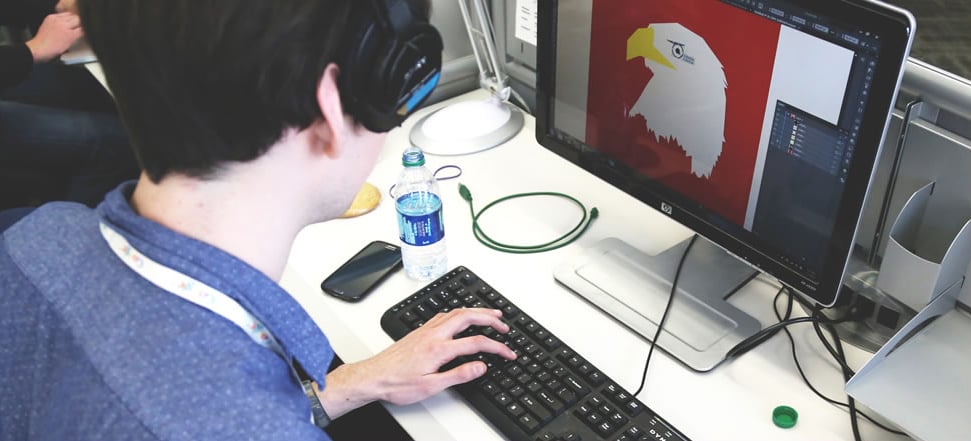
What is in this guide? An alphabetize:
- What is an ePortfolio?
- Why are ePortfolios beneficial for fine art students in particular?
- Things to consider earlier creating an ePortfolio with students
- ePortfolio layout and organization tips
- Choosing a platform: requirements for students
- Digital tools and platforms: the all-time online portfolio sites for students
- Bibliography
ePortfolio definition: The discussion 'ePortfolio' is shorthand for 'electronic portfolio,' and is sometimes known equally an east-portfolio, eFolio, iFolio, spider web-folio, digital sketchbook, digital portfolio, or online portfolio. Information technology is a place to brandish artistic work online (artwork, photographs, videos, designs, writing, and and then on), and may include hyperlinks, headings, navigation menus, and pages combining visual cloth and text.
ePortfolios in education: Electronic portfolios for students provide a place for students to record their learning, and then that material tin can be accessed remotely by a teacher, classmates and others. Student ePortfolios document learning over time, and provide a identify to store, analyze and reflect upon work.
An electronic portfolio (east-portfolio) is a purposeful collection of sample pupil work, demonstrations, and artifacts that showcase student's learning progression, achievement, and evidence of what students can practice.
Middle for Education & Learning, Berkeley, University of California[1]
In many cases, high school art students use ePortfolios in a similar way that is similar to a traditional art sketchbook with visual imagery displayed alongside typed notation.
ePortfolio evolution involves problem solving, decision-making, reflection, organisation, and critical thinking by students developing a learning 'story' that accurately represents skills learnt and competencies developed.
Dawn Bennett, Diana Blom, Peter Dunbar-Hall, Matthew Robert Hitchcock, Jennifer Rowley, ePortfolios for Creative Arts, Music and Arts Students in Australian Universities (2015) [2]
A well-executed e-portfolio program is an incredible tool for higher education. They provide institutions with authentic assessments of student learning and promote the deeper learning that we want for our students.
Candyce Reynolds, Associate Professor, quoted within The Benefits of E-portfolios for Students and Faculty in Their Own Words, Peer Review, Vol. 11, No. 1 (2009)[3]
Although it is well known that artists and designers benefit from displaying their work online (run across our guide to creating an artist website for more information about this), ePortfolios offering specific advantages to fine art students in detail:
ePortfolios can transmit sound and moving image
One of the all-time attributes of an ePortfolio is that, unlike traditional paper-based presentation methods, they tin include audio files, animated images (such as GIFs), and video footage, assuasive the communication of ideas via sound and movement. As such, ePortfolios are particularly popular among students who specialize in filmmaking, digital photography, spider web design, blitheness, app design, game design, and complex multi-media piece of work. Even those specializing in painting and cartoon and other two-dimensional formats are able to show videos of piece of work-in-progress, sound presentations, and so on, communicating in ways that are non possible with traditional methods.
Creating an ePortfolio promotes digital literacy and web design skills
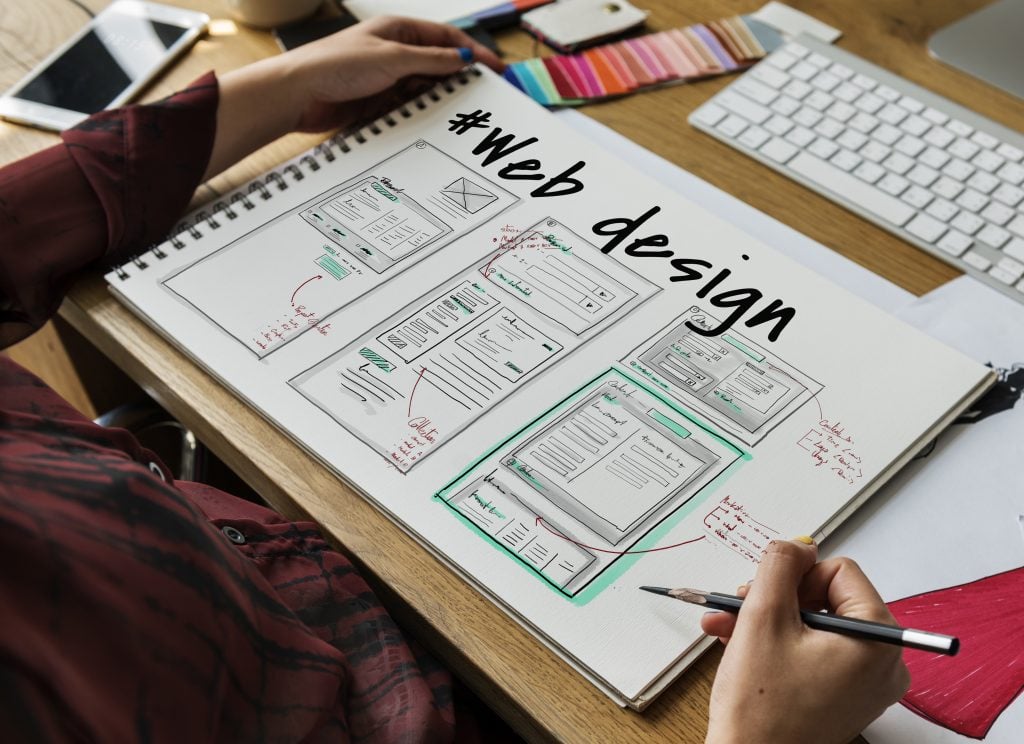
Many students already create logo designs and other graphic design outcomes equally part of their loftier school art programs: website pattern is a natural extension of this, with options to design the site layout, graphics and font. Many high schoolhouse qualifications take updated their curriculums to specifically include digital learning. For case, the Cambridge International AS and A Level Digital Media and Blueprint syllabus recently added the following area of study: "Mobile and multimedia applications include web and mobile applications, games, interactive media and digital installation." This syllabus, every bit practise most loftier school programs, includes many topics that could course part of an ePortfolio or web blueprint project.
Here is an instance of a last website pattern by a high school student in New Zealand:
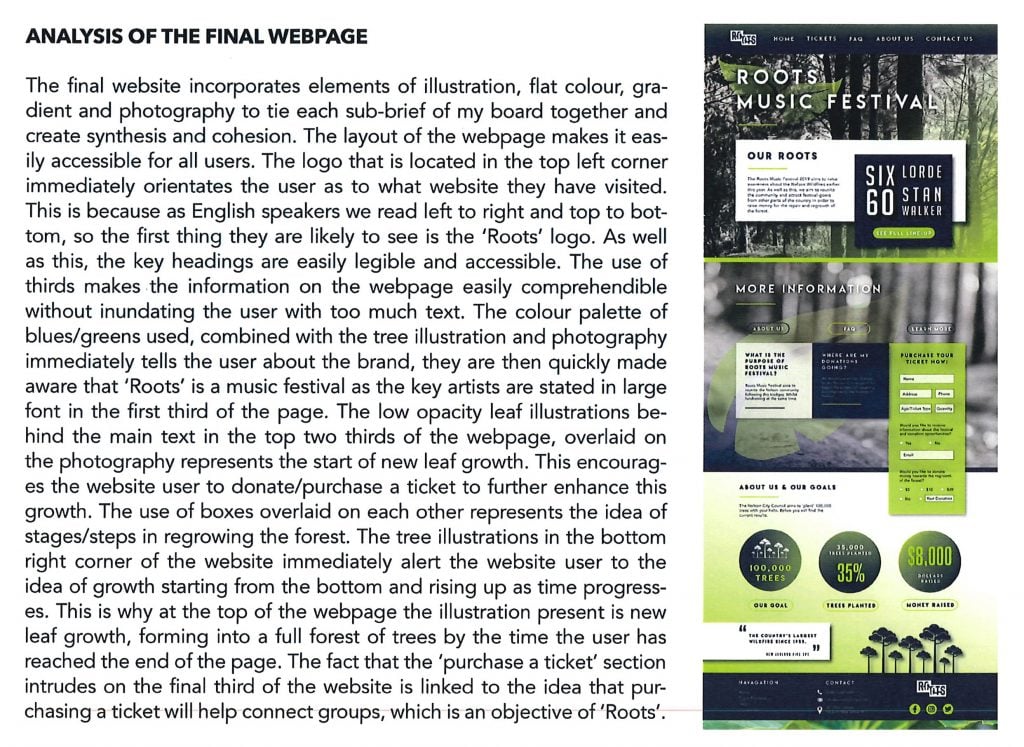
In other words, edifice an ePortfolio is non but an alternative manner of presenting artwork, but can be an integral way of coming together curriculum requirements, providing "an assessment manner that is more relevant to current and future students in the 21st century."[four]
Even creating a simple digital portfolio to display pupil work offers numerous transferrable skills. For instance, it encourages the use of scanners, video cameras, and other digital tools, as well as editing software, such as Adobe Photoshop. It too introduces students to web design or blogging software (meet below for a detailed discussion on the different ePortfolio platforms that are recommended for students). Having these skills gives students a leg up, regardless of the field they end upwardly entering.
ePortfolios reduce printing and reproduction costs
Graphic design and photography students typically face very loftier press costs, with students having to print out material for every assessment. Combined with the toll of a camera and software licenses, this tin can make such courses prohibitive for many students. Presenting piece of work via an ePortfolio, even so, eases this burden dramatically. When work is shared and assessed electronically, printings costs can be reduced significantly, with printing just taking place for final submission or exhibition pieces, for example. This also avoids the rush of 20-thirty students queuing for the printer, and is environmentally friendly to kicking.
Work can exist viewed remotely, without transporting of beefy physical items required
ePortfolios are not merely helpful for those studying digital arts, but those specializing in more than hands-on disciplines, such as drawing, painting, sewing, fabric design, sculpture and 3D Design. With face up-to-face learning currently disrupted in many parts of the earth, having a streamlined electronic system for displaying and sharing student work is helpful, specially when traditional sketchbooks, art supplies, and finished artworks are often bulky and difficult to transport. Fifty-fifty in ordinary circumstances, a mixture of digital and hard-copy submission tin help with infinite, storage and transportation problems in busy classrooms.
We have kids upload photos of their artwork and do essays and critiques, that way then that at that place is a lot less newspaper to behave around, a lot less trying to store artwork with that many students since nosotros accept such a large department and classroom space is limited.
Anonymous high school teacher, quoted by Jesse Strycker, K-12 Art Instructor Technology Use and Preparation, ScienceDirect (2020)[five]
Work can be viewed by many people at any time, fostering effective critique and in-procedure feedback
Many ePortfolio platforms have comment functionality built in, allowing students and teachers to offer productive written feedback (comment functionality can be switched off, if moderation becomes a problem). This is peculiarly successful with students who are less confident nigh providing verbal feedback in class. Teachers note that many enjoy the low-pressure nature of sharing critique online.
Accessing work via an ePortfolio, without the pupil needing to be nowadays, too allows teachers to provide individual formative feedback more readily than is always possible in a busy classroom situation.
The process of giving and receiving feedback was rapid and easy, and meant students were able to obtain more than private feedback than had previously been possible, and in a timely fashion, increasing its effectiveness (Gibbs, 2010).
Dawn Theresa Nicholson, Enhancing student engagement through online portfolio assessment, Practitioner Enquiry in College Pedagogy (2018) [4]
Within classrooms, ePortfolios can be projected onto a large screen, or viewed on individual computers, every bit Sandy De La Rosa describes:
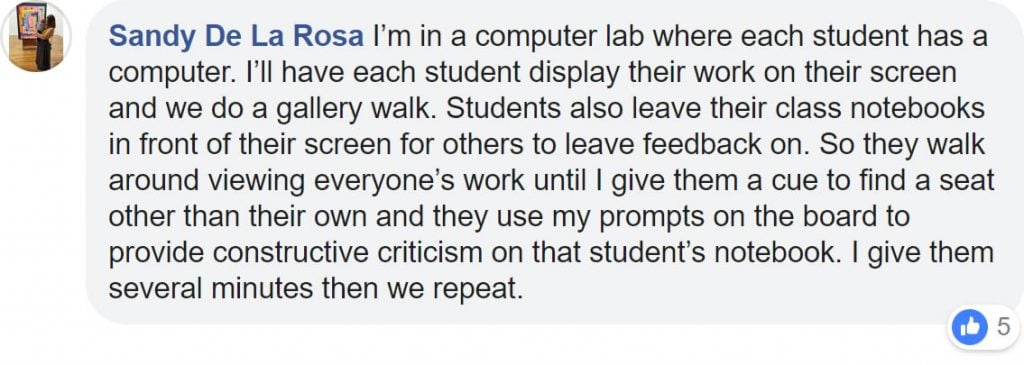
ePortfolios can increase educatee appointment
An interesting study[iv] recently compared two groups of university students, both of whom were asked to complete the same tasks. One group had to submit their piece of work via a newspaper-based portfolio; the other via an ePortfolio. (This written report ran beyond 2 years, with over 200 students in full, randomly split into groups). Teachers made the important observation that those who completed an ePortfolio were less likely to leave their piece of work until the last infinitesimal. It was suspected that this was because students knew that their teachers would periodically wait at their ePortfolio, but never knew exactly when, so they worked more regularly to keep their portfolio updated, simply in instance the teacher checked it. Teachers also noted that classroom discussions were oft more productive, because "students had already read and acted upon feedback."
Students made progress on their portfolios calendar week past week instead of leaving it all to the end. This was because they knew their sites were going to get displayed the following week…. and as well because they knew I was looking at their sites and prodding them if they hadn't done the work.
Anonymous tutor, quoted by Dawn Theresa Nicholson, Enhancing pupil engagement through online portfolio cess, Practitioner Research in College Educational activity (2018)[4]
In a high school setting, it is not but the teacher who might viewing and comment upon an ePortfolio in real-fourth dimension, merely classmates, parents, and peers. This increased feedback tin can result in increased levels of appointment. This finding is backed up past another 2022 study which found that ePortfolios promoted an "increase in student engagement and communication with the added benefit of connected learning in the secondary art classroom."[6]
ePortfolios tin double as a career portfolio, improving employment prospects
Many art students earn money from creative pursuits while studying, such as offering photography services, videography, or painting portraits for friends and peers. If an ePortfolio is set during high school, it tin can help students marketing their skills and achievements to potential clients and employers. An ePortfolio of this nature could include a resume and artist statement, alongside collections of artwork. (Delight annotation that students should be very careful about uploading contact phone numbers and other identifying details – come across our discussion most internet safety below.)
In fact, ePortfolios are considered so valuable for university students, that many institutions now crave students to create these as office of their course[vii] – in a wide range of disciplines, from education/teaching, music, to scientific discipline.
…more than four in 5 employers say an electronic portfolio would exist useful to them in ensuring that job applicants have the knowledge and skills they need to succeed in their visitor or arrangement.
Hart Enquiry Assembly, It Takes More than a Major: Employer Priorities for College Learning and Student Success (2013)[eight]
Senior high school students who are actively looking to enroll in college or university (encounter our guide to creating an application portfolio for college or university) can hence find creating an ePortfolio an excellent way to link learning to real-world goals.
[At] an urban high schoolhouse in northeastern Georgia, students frequently complained about their perceived disconnection betwixt classwork and the value of these assignments beyond high school; students made frequent remarks virtually ELA assignments like, "I'll never have to do this after high schoolhouse." Considering of these concerns, the researcher implemented an ePortfolio with a reflection on transferable skills every bit an intervention to help students reflect on the transferable skills practiced within high school coursework and its value in their futurity endeavors in college or a career. …[]… Findings from both the quantitative and qualitative data revealed that the ePortfolio with a reflection on transferable skills positively affected high school students' perceptions of college and career readiness in their high school.
Julie Beatrice Kristin, I'll Never Have to Do This Later Loftier School: Exploring Students' Perceptions of Higher and Career Readiness and the Effects of Eportfolios With Reflection on Transferable Skills (2020)[9]
ePortfolios tin can be used as promotional tools within the wider school and customs
Parents and school management teams are often impressed at the professional appearance of student ePortfolios. Online material tin can be projected onto big screens at open days and career nights, providing a 'virtual window' into the classroom, offering great marketing opportunities for the Fine art & Design section. Links to student ePortfolios tin can exist fabricated available from the school or teacher websites for similar reasons. Links to ePortfolios past past students tin can likewise showcase outstanding performance in various creative fields.

ePortfolios can streamline the grading process, collating work in a single location
Fine art teachers sometimes feel like vehement their hair out attempting to assess pupil piece of work that is scattered across several locations (a finished video clip on YouTube; obscurely labelled files in online folders; hardcopy drawings in a sketchbook; items on a misplaced thumb drive; and over-sized files fastened via electronic mail). This can go a logistical nightmare when collating and assessing work from hundreds of students.
An online ePortfolio acts every bit a fundamental hub, collating all work by a single student in one location (YouTube videos tin exist embedded, prototype files uploaded, notation added directly alongside, and even concrete artworks tin can be scanned an added).
Each carve up consignment of sub-unit of piece of work can be presented upon a single ePortfolio page, with the teacher scrolling upward or down equally required to view the entire submission. With this method, each student 'submits' only a single link for cess. Inboxes are not clogged; files do not need to be painstakingly opened one at a time. The teacher opens the appropriate link, and the unabridged submission is visible – images, multi-media, and text, bundled upon a single portfolio page.
Although critiquing student work from unmarried ePortfolio page is often non as unproblematic as assessing hardcopy work directly in forepart of y'all, it is far amend than other digital alternatives. It also has the advantage that teachers don't need to behave armloads of work to-and-from school, and can grade anywhere that they have internet access. This submission technique also allows regular formative feedback to exist given via comment features, every bit described higher up.
Updating and modifying piece of work is easy
A digital portfolio can be edited, improved and updated equally the course progresses, providing a flexible digital document to back-trail hardcopy sketchbooks.
Students have been stuffing assignments in notebooks and folders for years, then what's so new and exciting nearly portfolios? Portfolios capitalize on students' natural tendency to save work and go an effective fashion to go them to accept a 2nd await and recollect about how they could improve future work. Equally any teacher or educatee tin can ostend, this method is a clear departure from the one-time write, hand in, and forget mentality, where offset drafts were considered final products.
David Sugariness, Student Portfolios: Classroom Uses, Pedagogy Inquiry Consumer Guide (1993)[x]
There are several issues to consider earlier creating an ePortfolio with high school students, particularly if this is to exist live on the internet, attainable by the public. (Most ePortfolio platforms have the ability to fix these every bit either public or private.)
Net rubber and privacy: seek parental permission and ensure no contact details are included
Sharing work online involves potential complications with cyberspace safety and privacy. It is vital that students and their families consent to sharing of work via the digital platform and understand what the ePortfolio will involve. Teachers should familiarize themselves with school policies around sharing student work with third parties.
Students should ensure that telephone numbers, age, addresses and other identifying details are not included within their ePortfolio. If creating an ePortfolio for marketing purposes, where students desire to encourage potential clients, a 'contact grade' should be used, rather than making an email address publicly visible (automatic bots clamber the cyberspace 'harvesting' e-mail addresses, so that they tin be sold to others for spam email purposes, so publishing an email addresses online is non advised).
Some schools request that students do not include their full proper name, and utilise only an initial for their surname, however, a full name tin can be helpful for building an online presence, so as long every bit no contact details are included, this is unremarkably okay.
Ensure content is appropriate for a classroom situation: respectful language, inoffensive imagery
One of the most of import things students must empathise before posting content to an online ePortfolio is that what goes online, stays online. It is good practice to assume that everything published on the internet (whether to social media, a 'individual' Facebook group, your own ePortfolio, or otherwise) might be seen past vast numbers of people, and that, once uploaded, yous may never be able to remove it or undo information technology. Numerous automated robots, as well as humans, re-create and duplicate digital material, and sometimes the most unexpected content goes viral. Furthermore, the 'WayBack Motorcar' takes permanent snapshots of web pages, archiving the cyberspace, so that web pages can be accessed at a afterwards date even if the material is later taken offline. In short, once fabric is uploaded to the internet, it is often there permanently, and the original uploader loses command over how it is used or shared. In rare cases, you lot can quickly delete material before anyone else has seen it, but yous should not count on this. Even isolated comments on someone else's website may come back to haunt, as this man discovered:
…he has commented on someone else's post and been very offensive towards them. His comments were rude and ill thought out, and were made some six years ago. He has now realised his comments tin can be institute in Google when a search is made for his proper name – something he didn't remember would happen when he fabricated the comments.
Darren Jamieson, What happens online stays online (2016)[11]
Questionable content posted online can compromise students not just in the present, simply in the futurity – in unanticipated ways. For this reason, schoolhouse administration / management are more than probable to become involved if objectionable content is shared with an ePortfolio than had the aforementioned cloth been shared in a hardcopy classroom sketchbook – considering the ramifications are much more serious.
Information technology is worth remembering that most students share content online on a regular basis anyway, and will proceed to do so, whether they are granted permission to create an ePortfolio as function of a schoolhouse projection or not. Hence, this task provides an excellent opportunity to assistance students develop responsible strategies for communicating online.
Protect against plagiarism
If work from artists or other individuals is included or quoted within an ePortfolio, this should be formally referenced, as within any other academic project.
There is sometimes the worry that students from one school might plagiarise the work of students from another. Some teachers get around this by having the online portfolio equally an terminate-of-year projection that takes identify after work after has been formally submitted – or by having the portfolios accessible online, simply not discoverable by search engines, so that the ePortfolio cannot be easily constitute by others (the portfolio can then be fabricated public one time the course is consummate). It is worth noting, all the same, that many high school fine art projects are inspired by multiple practising artists, with ideas developed under the guidance of a teacher in original directions. Hence, mimicking of artwork by unmarried educatee is hence not usually a major business concern.
Verification of ownership: Include screenshots of piece of work in progress and accompany digital submissions with concrete artwork
Many qualifications require a schoolhouse or principal to verify the authenticity of student work earlier information technology is submitted for external assessment. This can be more challenging when work is submitted digitally, considering it is harder to know whether piece of work has been copied from elsewhere. For this reason, students should document piece of work in progress – showing screenshots at various stages of completion.
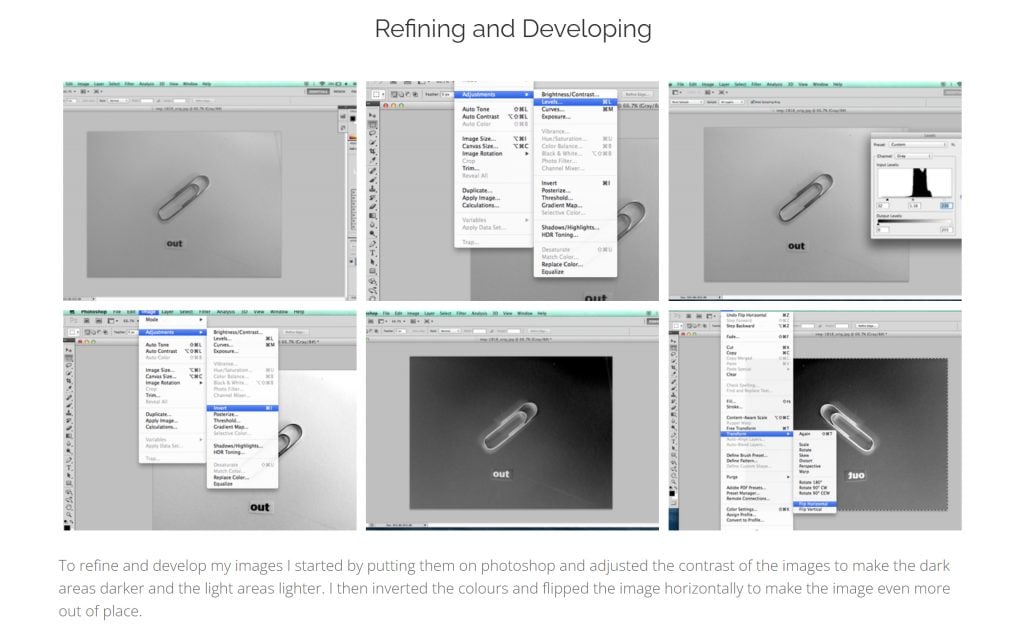
It is also helpful to accompanying digital submissions with hardcopy sketchbooks or artwork, to aid to verify ownership of digital piece of work.
Remainder screen fourth dimension with hands-on creation
There are valid concerns most the number of hours young people spend online – something that is just escalating with the lockdowns taking place in many parts of the world. Long hours online and the distraction of social media can impact mood and slumber, compromising productivity and quality of work overall. This is an important consideration when making a choice about what part an ePortfolio volition play in the classroom.
In that location is an immediacy and joy in creating hands-on artwork that is sometimes lacking when interfacing betwixt keyboard and screen. Fine art students oft dearest the chance to collaborate with physical media, using their easily to create things – experiencing surface and texture and bear upon. Creating physical artworks allows the spontaneous transfer of ideas by manus, and strengthens and consolidates applied fine art-making techniques.
For this reason, students might choose to delay ePortfolio cosmos until the senior years of loftier school, leaving the earlier formative years to focus predominantly upon applied art-making skills. Fifty-fifty senior students creating digital art courses do good from sketching and experimenting with physical media alongside the cosmos of an digital work (this also helps with verifying ownership of work, equally noted above).
Backup the ePortfolio
Digital files used inside an ePortfolio should be stored on a retentiveness stick or cloud server (an automatic backup service, such as Dropbox, is recommended). It is also wise to print a copy of each ePortfolio page. These printouts tin can exist leap and submitted and then that examiners have a physical copy in case of technological difficulties.
Not all teachers detect assessing pupil ePortfolios straightforward – with some commenting that it sometimes feels like a "wild goose chase" to locate the advisable item for assessment.[4] The process is much easier if teachers utilize a consistent class-wide ePortfolio structure and page-labelling, every bit this enables teachers to navigate direct to the advisable folio in each educatee's ePortfolio without hiccup.
In the evaluation, staff expressed potent feelings most the mark procedure. For some, the process was much improved, while for others, more than challenging. The difference appeared to chronicle largely to the arrangement, construction, and formatting of students' spider web sites:
How well the students fix the WordPress site, and how they chose to post their portfolio elements, made a significant difference to how easy it was to review work.
Dawn Theresa Nicholson, Enhancing educatee engagement through online portfolio assessment, Practitioner Research in Higher Educational activity, Vol. 11, No. 1 (2018)[four]
At that place are no fixed rules about how to set upward an ePortfolio, nonetheless most good ePortfolios utilise a similar layout and organizational structure. This helps teachers and assessors navigate around the site and view the piece of work without difficulty.
If the purpose and assessment criteria of portfolio are not clear, the portfolio can be just a miscellaneous collection of works that can't reverberate students' growth or achievement accurately.
Adnan Baki, Osman Birgin, The Use of Portfolio to Appraise Student's Operation (2007)[12]
Make a new page for each assignment or unit of work
Students should not haphazardly dump work within the ePortfolio, nor space work out across hundreds of disconnected pages. It is advantageous to publish each assignment or unit of piece of work on its own folio, integrating artist inquiry, annotation, reflections, and collections of images and ideas in the one location. This allows the marker to curl up and downwards to assess the work, without having to click back and forrard between multiple pages. (This is skillful practice for professional career ePortfolios besides, every bit having more than content on a single page makes information technology easier for Google to sympathise what each folio is about and helps bulldoze traffic to your website – more tips for growing traffic to an artist website will discussed in an upcoming article).
Include a menu, with clearly labelled navigation links

Include a navigation menu at the elevation of the screen (above or below the master heading) with links to different sections of work within the ePortfolio. A drib-down menu tin can be used to group pages together in categories and sub-categories. The menu should use clear, easily-understood wording. Teachers frequently have specific rules and naming protocols for menu items, so that they can locate work without difficulty.
Bill of fare items should exist ordered sequentially, to show progression of ideas, and should include a link to the habitation folio, and other central pages (such as an 'About Me' and 'Contact' page, which are useful for those wishing to use the ePortfolio for career purposes). A second menu can as well exist included in the footer of the site (at the very bottom of the page).
Ensure content views well upon dissimilar screen sizes, with images and text clearly visible
Sometimes as a browser resizes, images and text spring positions, so that what worked well on one screen does not view well on some other. Students should resize their browser and view on dissimilar devices, to check how the work displays at other screen sizes.
It is hard for examiners to assess work when only part of an prototype is visible at one time. Recollect that examiners are likely to appraise student work upon a desktop. If you have tall, narrow artwork, reduce the file size so that the entire artwork is visible on a single horizontal screen. If fine details are not visible at this scale, carve up photos can be added showing close-upward details.
When annotating artwork, it is helpful if the images are visible on the screen at the same time every bit the text, so information technology is articulate which images are being discussed.

Utilize hyperlinks to connect dissimilar parts of the portfolio and link to external websites
Hyperlinks play an of import function in helping Google'south search algorithm understand online content, and help an ePortfolio exist visible in search engines – oft an important goal for students wishing to grow their online presence and develop an art career. Hyperlinks too help teachers and assessors navigate their way around your site.
When referencing piece of work from others, it is good etiquette to link to the original source, and so that those wishing to seek more information can click through and visit the appropriate website.
Use a simple presentation style
A creative ePortfolio is more merely a place to dump work – the presentation matters. Put thought into color and font selection, aiming for like shooting fish in a barrel readability. When arranging content on pages, remember that overcrowded work or tiny font sizes may get in hard for examiners to appraise work. As with a traditional sketchbook, a clean, minimalist aesthetic is desirable, as this does not distract from the artwork (more ideas nigh presentation can be plant in our guide to creating an outstanding high school sketchbook).
Introduce the project on the 'Habitation' page
The front page of the ePortfolio is likely to be the starting time affair that an examiner will run across. Use this as an opportunity to summarise the project and outline the purpose of their ePortfolio, calculation links to the different cardinal areas of the project.
Add together an 'About Me' folio
An About Me folio is particularly important in the case of a career portfolio. Students tin can add data nigh themselves hither, including the creative services they offer. Students may also include a photo of themselves (many cull to have the face obscured or hidden for privacy reasons).
Here is role of the text used on an About Me ePortfolio example past a college student seeking to promote her piece of work and proceeds clients:
Hullo and welcome! I'm glad you're here!
My name'due south Carter Teal, owner and main photographer of Carter Teal Photography! I'm currently a college student at The Ohio State Academy pursuing a field in their Blueprint program. I'thou based in Central Ohio and I shoot weddings, couples, portraits, families, and much more!
Carter Teal, Carter Teal Photography
When selecting where to make an ePortfolio with students, the following should be considered:
The ePortfolio should be portable, and then students tin can apply it beyond graduation
Ideally, pupil ePortfolios should non be tied to school systems, so they are accessible in one case students accept left school – making them helpful for both higher and university applications, and beyond. Although material tin can exist manually copied and paste material from in-house platforms for future use, doing this at calibration, with multiple students is impractical.
The example was made that PGCE students would be inbound the world of work the following yr and therefore should accept immediate access to their portfolios as continuous professional person development tools…
Magda Barnard and Sonja Strydom, A tale of two faculties: Exploring student experiences of e-portfolio implementation as a vehicle of cogitating learning at Stellenbosch University, The Independent Journal of Pedagogy and Learning, Vol. 12, No. 2 (2017)[13]
The platform must exist reliable, robust, and secure
A stable, well-established digital platform is essential. The longer a platform has been operating, with an active user base, the more likely it is to exist secure, without bugs and technical bug. Popular platforms are as well accompanied by a huge array of tutorials and preparation videos to help when students get stuck.
The platform must be simple to use
Young people are often described as 'digital natives', however a platform used with high school students must cater towards all skill levels and be sufficiently straight frontwards and user-friendly.
…despite engaging with so-called 'millennials', information technology was articulate that the assumption could not be fabricated that all the students were comfortable with the required technologies and that they knew how to apply them as expected. …[]…most of the accomplice asked for a more easily-on preparation experience related to multimedia skills (east.g. adding images, videos and sound clips) and granting access to their corresponding portfolios at the start of the project…
Magda Barnard and Sonja Strydom, A tale of two faculties: Exploring student experiences of e-portfolio implementation as a vehicle of reflective learning at Stellenbosch University, The Independent Journal of Instruction and Learning, Vol. 12, No. 2 (2017)[13]
The platform must be flexible and customizable
Fine art students are peachy to add their ain mark to their creations. This is particularly critical if students promise to use an ePortfolio for enhancing their career after graduation. The best ePortfolio platforms allow room for cocky-expression, selecting different layouts, fonts, colors and so on.
The platform should take comment functionality
As noted above, engagement is ofttimes driven by comments and responses from teachers and classmates. You may wish to ensure it is possible to switch comments on and off, every bit desired.
The platform should be costless or cheap to use
Gratis ePortfolio websites for students are popular for obvious reasons, notwithstanding these come with downsides that must be considered too. Some schools use savings fabricated in press budgets to cover costs of high-quality ePortfolio platforms. Both paid and premium options, with their pros and cons, are discussed below.
Information technology can be helpful to use the same platform schoolhouse-broad
If you are creating ePortfolios within the classroom, having all students select the same platform makes teaching and grading more efficient. Teachers can apply a common gear up of resource between year levels (some teachers also create their own website using the aforementioned platform, modelling skillful exercise for students and learning how to employ the platform together). A school-wide policy ways that students all get familiar with the same platform – and so changing classes and year levels doesn't involve relearning how to use some other platform all over once again.
When students spend more than i year working with digital portfolios, they acquire and know the tool. This means students aren't bogged down with learning the technical stuff. They volition go fluent with the technology and be able to concentrate on creation, curation, reflection, connections, and all the things that will really bulldoze their learning.
Greg Port, Why ePortfolios, All Saints' College (2020)[14]
In that location is an nigh infinite assortment of digital tools and software that for making an ePortfolio. Here we discuss their pros and cons, discussing their usefulness within the classroom, and illustrating how some of the best ePortfolio platforms have been used within high school fine art programmes.

Image-sharing platforms, such as Google Photos, Instagram, Flickr, Padlet, Pinterest, or Artsonia
There are many online platforms where images can be uploaded and organised in folders. These provide a place to store and share images, and are sometimes used past students to generate a simple online portfolio. Teachers and students sometimes create accounts and then follow each other, or contribute to shared folders, groups, or noticeboards. Some of these platforms, such as Google Photos and Flickr, retain technical data about each photograph (such as the photographic camera model, aperture, and and so on) which is helpful for photography students.
Padlet and Pinterest let users to create collaborative online noticeboards or collections, where students and teachers tin can post images, videos, and links. Padlet has both gratis and premium versions (a paid teacher license is bachelor), with the free Padlet version limited to simply iii noticeboards. Padlet has an improved ability to manage harassment and privacy (you lot can ensure that content is 'approved' before information technology is published, for example), making it suitable for utilize in classroom situations, particularly with junior students.
Artsonia is a website where educatee artwork can be uploaded to galleries, so printed upon various products (such every bit cups, magnets, T-shirts etc), fundraising for schools in the procedure. Some teachers use this to create basic online portfolios for students. It sometimes takes a lot of time to prepare and manage permissions, still when students upload their ain piece of work using their phones this makes the process much easier.
Public paradigm-sharing platforms, like Pinterest and Instagram, expose students to content from a wide range of users, which tin can be inappropriate or distracting.
There are three principal difficulties with these image-sharing platforms, when it comes to ePortfolio creation. Firstly, multiple images and text cannot be easily arranged in sequence upon a single portfolio page, making them unsuitable for many high school programs. Secondly, it is non easy to link or navigate between different sections of the portfolio, or organize content into categories and sub-categories. Thirdly, these platforms exercise not make information technology piece of cake to optimize content for search engines, then people are less probable to discover your work while searching in Google. This makes them unsuitable for those students who are looking to create an ePortfolio to promote their career in the future.
School-based platforms such as Canvas or Seesaw
Another alternative is to use your current learning management software for ePortfolio creation. Some students use Sail to submit digital art and graphic design assignments (Colorado Country University has published a good guide for how to make an ePortfolio on Canvas). Seesaw is some other platform that enables students to turn in artwork, with images to be organized in folders and viewable as a public online gallery, with students integrating images, video, text and and then on. Other popular school-based platforms include Google Classroom, Edmodo, or Schoology. The disadvantages of these options is that ePortfolios remain tied to the school learning management system, and are not an easily transportable portfolio that is useful for higher applications or career promotion going forward. Every bit with the content-sharing platforms higher up, these approaches are best used with junior students, or those who are less serious about embarking upon a creative career.
Slideshow tools, such as PowerPoint and Google Slides
Slide-sharing platforms permit students to make a digital presentation in the course of a digital slideshow. This involves a combination of scanned drawings and paintings, photographs, digital artwork, embedded videos and 'voice overs', assembled alongside reflections, analysis and other typed notation. Digital slideshows can exist presented to class for discussion and critique, or used for college applications. Some high school qualifications, such equally IB Visual Art, require students to submit a series of screen-based slides for assessment, using software such every bit PowerPoint.
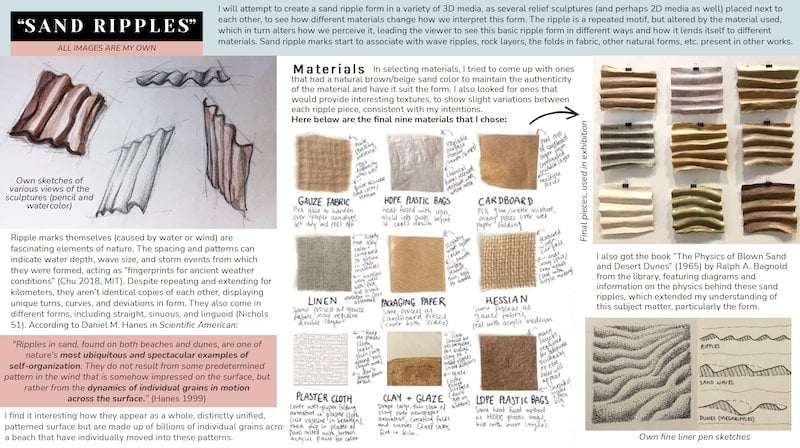
Google Slides is much like PowerPoint, except that students tin share links to their presentation or embed these within a blog post, making them more transportable. Students can create presentations using a template created by the teacher, if required. Teachers frequently find that Google Slides is piece of cake for students to use, with a low learning-bend, although at that place are complaints about the way Google Slides compresses images, which tin leave images blurry.
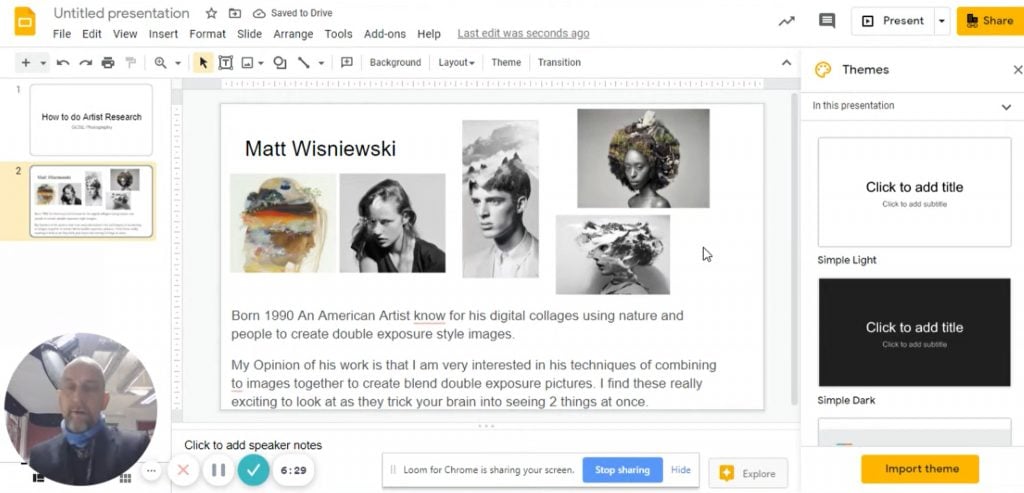
One event with using slide-sharing tools is that submitting an entire year'south piece of work in a single slideshow makes for a very long, heavy certificate. Some schools thus ask educatee to submit a separate slideshow for each unit of work. Although slideshow tools can exist used to create complex, high-quality presentations, unlike an ePortfolio website, they cannot be easily used to abound exposure online and are hence not every bit useful for career purposes.
Professional portfolio platforms such as Adobe Creative Cloud Limited or Behance
Some other option is to use one of the free platforms used by artists and designers, such as Behance or Adobe Creative Cloud Express (formerly known as Adobe Spark). These permit yous to combine images and text upon website pages (enabling you to scroll down to see all content, rather than clicking through folio after page). These are published online, easily shareable with others, and tin can be retained by the students afterward they leave school.
Platforms such as Adobe Creative Deject Express and Behance are typically aesthetically pleasing and piece of cake to use, so students can become up and running with ease. Students often detect it motivating to have their piece of work published alongside that of practicing artists and designers (and experience as if they are creating a 'real' portfolio) which can encourage high-quality portfolio creation.
Here is an first-class Adobe Spark tutorial past Design and Photography teacher Stacey Churchill, describing how she uses ePortfolios within the classroom):
Annotation: Do not make the mistake of confusing Adobe Spark with Adobe Portfolio. A number of teachers have had students employ Adobe Portfolio, only to discover at the end of the projection that it won't permit students publish their portfolio without payment.
There are two issues with these gratis portfolio platforms. Firstly, they typically have very limited customization options. Many senior high schoolhouse students find these platforms not flexible plenty for their needs. Adobe Spark also doesn't allow comments and students cannot 'like' images, which some teachers find reduces engagement inside the classroom. Most importantly, however, ePortfolios created using these platforms cannot exist easily optimized for search engines, so it is difficult for others to find the portfolio when searching in Google. This means these platforms have express usefulness if students promise to apply the ePortfolio to grow a client base and promote themselves in the hereafter.
A gratuitous web blueprint platform such as Wix, Weebly, Google Sites or Blogger
Creating a stand-alone website is the best choice for senior loftier schoolhouse students who wish to create an ePortfolio. Many students utilize a gratuitous spider web design platforms, such every bit Google Sites, Blogger, Weebly, or Wix. These platforms have drag-and-drop editors, and so students tin create a website without any HTML or coding required.
Wix or Weebly are the nearly versatile of these options, and have a professional, aesthetically pleasing appearance, resulting in a site that tin can be kept following graduation, useful for scholarships and college applications. Both Wix and Weebly have free and premium options.
Here is an excellent Weebly ePortfolio example past a senior high school pupil:
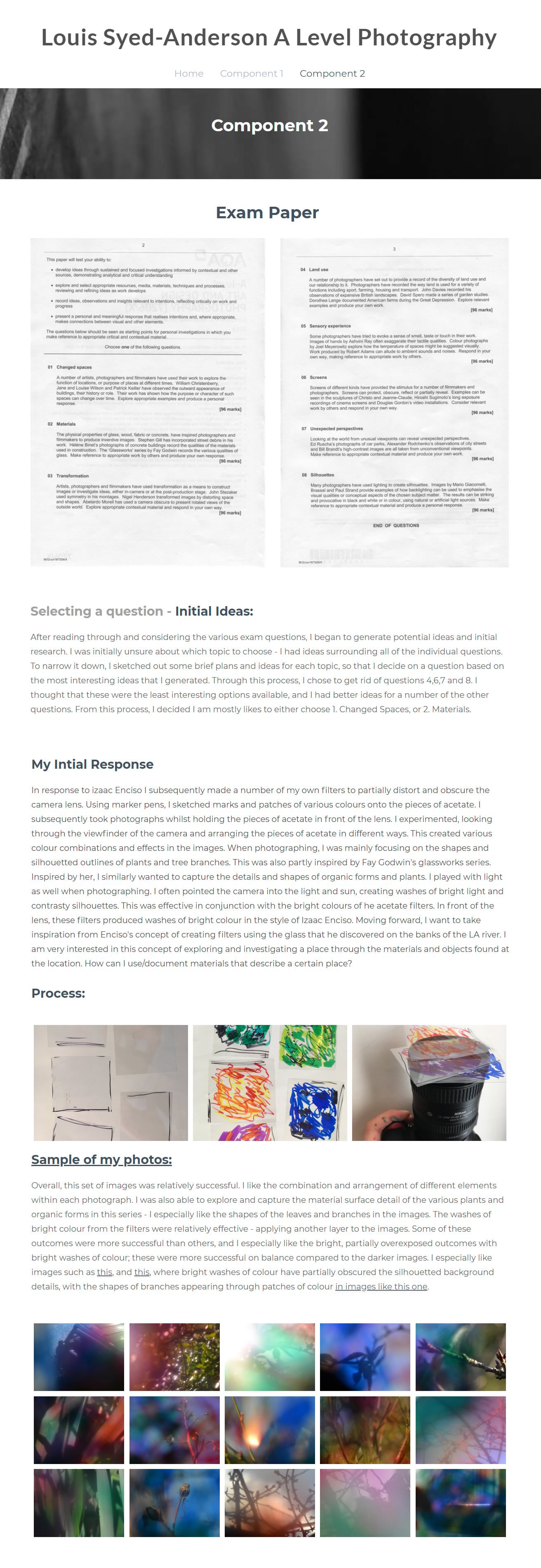
Another option is Google Sites (this is the best Google service for creating an ePortfolio).
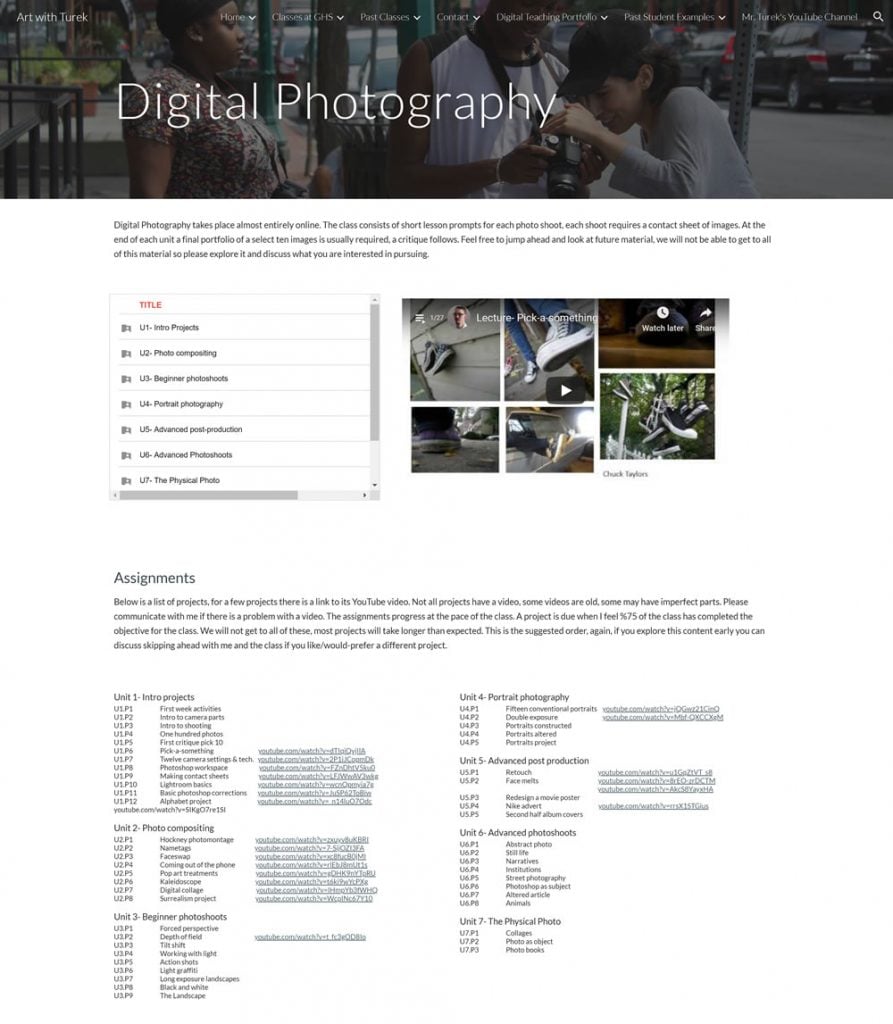
Wondering how to create an ePortfolio using google sites? Here is a great tutorial by Eric Neely, English language teacher at The Academies of Bryan Station Loftier School, Kentucky, United states of america:
Google sites is very easy to apply, however some observe it challenging to share educatee portfolio Google Sites with others (one teacher described "constantly dealing with blocking problems when they wanted to ship to family unit members or outside agencies"). If a site is created using a student's schoolhouse login, a copy of the site tin exist shared with their personal Gmail account when the student leaves, then they tin can retain it once they leave schoolhouse, all the same this requires a few steps and may become a hassle when portfolios are created past multiple students. Other schools cannot use Google Sites at all (those designated as 'Microsoft schools' for case), considering their students don't use Gmail accounts. Some teachers have besides commented that students cannot upload images directly from their phone to Google Sites – work must be saved in Google Drive so uploaded them to Google Sites, meaning an extra step in the procedure.
Another Google platform that tin be used to create a website is Blogger. This is an older platform, however it is still used by some students and teachers.
A trouble encountered by many teachers wanting to create an ePortfolio for students is that a growing number of gratuitous platforms are blocked by schools. Sometimes, students or teachers spend considerable effort building up a website or ePortfolio, or are halfway through a projection, when the platform is suddenly blocked by their school, as loftier school photography teacher Wendy Brownish McElfish discovered first-mitt:

Complimentary ePortfolio platforms are ofttimes blocked by schools because these sites attract spammers, who look for cheap and piece of cake ways to fix dodgy websites. To protect students from exposure to these spammy sites, the whole platform itself is oft blocked and inaccessible past students.
To complicate things further, many regions are bringing in laws and regulations relating to online education, which means that certain platforms are no longer able to be used with students. For instance, teachers in New York State were recently told they were unable to utilise Weebly anymore, as this is non compliant with the new 2022 NYS data collection privacy law. Other teachers are no longer able to use Wix with their students, due to new age restrictions brought in, with some teachers but let those older than 18 to publish a site.
Another downside of edifice an ePortfolio with these tools, is that free platforms are prone to close downwards unexpectedly. For case, Weebly recently announced that their education plan (which enabled teachers to manage and view student websites) will soon be discontinued, with all student sites and accounts disabled. Students volition not be able to export their websites, requiring students to manually cut and paste all cloth if they wish to proceed their content.
[Weebly] will no longer support educatee accounts after August 1st, 2022. Students volition not be able to log in, and their websites will be unpublished. We'll delete any student information in your account…
As some other example, Wikispaces, which was ane of the largest educational wiki sites used past teachers, suddenly disabled all complimentary and classroom wikis in 2022:
As stated in our communication in January 2022 and subsequent site banners; as of July 31st, 2022 all Free and Classroom Wikis were disabled and are no longer attainable.
Gratis website platforms are particularly vulnerable to collapse, because they practice not straight generate revenue for the company. When times are tough, free services are often the first to exist cut. Such abrupt changes tin can have rather dramatic furnishings upon teaching programs, when hundreds of students might be midway through projects using a detail platform for their course.
Another downside of using one of these platforms is that Google does not like to bear witness complimentary websites in search engines (ePortfolios made using these tools are hence not very useful for driving traffic or growing clients – see more about this in our guide to creating an artist website) and optimizing content for search engines is difficult. This makes ePortfolios built with Wix, Weebly, and Google Sites far less useful for students who are groovy to embark upon a creative career, because it is much harder to drive traffic to these websites.
WordPress (highly recommended)
WordPress is 1 of the most popular website edifice tools, and powers almost 38% of all websites on the internet (the Student Fine art Guide was created using WordPress). It can be used to create whatever type of website, with written text, illustrated articles, scrolling images, epitome galleries, embedded video clips, and so on. WordPress is more than complicated than Wix and Weebly, but is well within the capabilities of many senior high school students. By comparing, it is easier to use than other digital tools students often use, such as Adobe Photoshop.
Many teachers give students a choice between Wix, Weebly, Google Sites, and WordPress. Ane loftier school instructor comments, "Wix seems to be the crowd favorite, with some of my advanced students using WordPress." Another writes, "Been using Wix for several years. WordPress for the real serious kids."
Important advantages of WordPress include:
- A WordPress website tin be optimized for online search engines, making information technology easier for others to find your artwork when they search in Google. (This is why WordPress is the all-time pick for practising artists).
- Students tin can have their own website proper noun (this is called a 'domain name'), such as yourname.com. This creates a much more professional person impression than yourname.freeservice.com.
- If students decide to sell artwork in the future, they can easily add buy now buttons or shopping carts and sell directly from their WordPress site (this is non possible from the free platforms described above).
- An almost infinite range of features can exist added to a WordPress website – contact forms, email sign-upwardly boxes, social media share buttons and so on. All of these are invaluable and are hard or incommunicable to implement on most free platforms, enabling students to turn their ePortfolio is a professional website.
In fact, WordPress is considered so useful for students that a growing number of loftier schools at present offer WordPress specific courses. High school instructor Zac Gordon, for example, describes teaching students to build websites for clients in the customs, and began an internship program, where students started their ain companies working on WordPress sites for clients.
There are ii versions of WordPress – the basic, gratis version, which is found at WordPress.com (this has many of the same limitations as the other gratuitous platforms described above), and self-hosted WordPress, which is installed at a 'website host'. A website host is a company that offers infinite for a website to exist stored online and then your site is live on the net. Beginner hosting costs approximately $5 a calendar month (see recommendations for hosting providers at the end of this article – the same hosting providers nosotros recommend for artists). This price is within the reach of some loftier school students – particularly when savings in press are considered. (Some teachers add website hosting to the form fees at the beginning of the twelvemonth, in replace of a reduced print budget.)
The Student Fine art Guide will before long be publishing a free WordPress course for high schoolhouse students, containing all resources and lesson plans needed to teach WordPress inside the classroom. This will be an online grade that students and teachers tin follow along at their ain pace. Information technology volition teach students how to build a website with WordPress, and volition include lesson plans covering the many ways in which web design can be utilized inside the curriculum – such as logo design, website layout design, and digital branding etc. We hope to publish this form in 2022. In the concurrently, students may wish to picket the video tutorial we have created for artists explaining how to set upward a WordPress website.
Note: We are not bad to characteristic more than student websites, particularly WordPress ePortfolio examples, within this article. Practise you accept examples or experience using WordPress within the classroom that you would like to share? Take your students designed websites as office of their high school curriculum? Please make contact via our contact course! We would love to hear from yous.
If you accept found this article helpful, please share using the social media buttons at the lesser of this page. Cheers!
BIBLIOGRAPHY
[i] E-Portfolio, Center for Teaching & Learning, Berkeley, University of California
[2] Dawn Bennett, Diana Blom, Peter Dunbar-Hall, Matthew Robert Hitchcock, Jennifer Rowley, ePortfolios for Artistic Arts, Music and Arts Students in Australian Universities (2015)
[iii] Candyce Reynolds, Associate Professor, quoted within The Benefits of Due east-portfolios for Students and Faculty in Their Own Words, Peer Review, Vol. 11, No. 1 (2009)
[four] Dawn Theresa Nicholson, Enhancing educatee engagement through online portfolio cess, Practitioner Research in Higher Educational activity, Vol. xi, No. ane (2018)
[5] Jesse Strycker, G-12 Art Teacher Technology Use and Preparation, ScienceDirect (2020)
[6] Megan Johnson and Maia Skarphol, The Furnishings of Digital Portfolios and Flipgrid on Student Appointment and Communication in a Connected Learning Secondary Visual Arts Classroom (2018)
[7] Planning & Developing Your Public Portfolio, Louisiana State University
[8] Hart Inquiry Associates, It Takes More than a Major: Employer Priorities for Higher Learning and Educatee Success (2013)
[9] Julie Beatrice Kristin, I'll Never Have to Do This After High School: Exploring Students' Perceptions of Higher and Career Readiness and the Effects of Eportfolios With Reflection on Transferable Skills (2020)
[10] David Sugariness, Student Portfolios: Classroom Uses, Didactics Research Consumer Guide (1993)
[xi] Darren Jamieson, What happens online stays online (2016)
[12] Adnan Baki, Osman Birgin, The Use of Portfolio to Appraise Student'due south Performance (2007)
[13] Magda Barnard and Sonja Strydom, A tale of two faculties: Exploring student experiences of e-portfolio implementation equally a vehicle of reflective learning at Stellenbosch University, The Independent Journal of Teaching and Learning, Vol. 12, No. ii (2017)
[fourteen] Greg Port, Why ePortfolios, All Saints' College (2020)
[xv] Digital Portfolios: Guidelines for Beginners, Ian Munro, Ministry building of Teaching, New Zealand (2011)

Amiria has been an Art & Design teacher and a Curriculum Co-ordinator for seven years, responsible for the class pattern and cess of student work in two high-achieving Auckland schools. She has a Bachelor of Architectural Studies, Bachelor of Compages (Kickoff Grade Honours) and a Graduate Diploma of Teaching. Amiria is a CIE Accredited Fine art & Design Coursework Assessor.
How To Set Up An Eportfolio,
Source: https://www.studentartguide.com/articles/how-to-make-an-eportfolio-for-students
Posted by: salmonsbaccough.blogspot.com


0 Response to "How To Set Up An Eportfolio"
Post a Comment